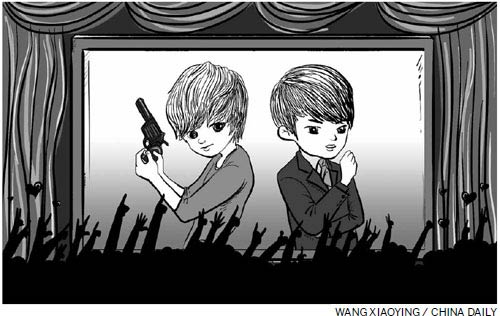當前位置: Language Tips> 雙語新聞
TV dramas need creative touch
分享到

|
A Korean wave is sweeping across China, with many Chinese women worshipping South Korean actors Kim Soo-hyun and Lee Min-ho as demigods. Chinese netizens have always been divided over South Korean TV dramas, but there is no doubt that programs from the neighboring country are now enjoying a new round of popularity in China. And a big part of the credit for that goes to You Who Came From The Star, the South Korean TV series which is on the air now. Top South Korean actors Jun Ji-hyun and Kim Soo-hyun recently earned a popularity rating of 24.8 percent in their country, considered strong by Nielsen Korea. You Who Came From The Star and The Heirs have been subjects of hot online discussions throughout Asia. Besides, the book, The Miraculous Journey of Edward Tulane, read by the hero in You Who Came From The Star was a hard-to-get item on Amazon for a while. The two TV programs have several common elements: a tall, handsome, and rich hero who loves the heroine blindly and always protects her, and an equally handsome man madly in love with the same woman. Both programs portray the purity of love, which is expressed through a kiss or a warm hug. Perhaps that's the secret of their success; perhaps people are still fascinated by Cinderella-type stories. The widening wealth gap is a matter of social concern both in South Korea and China, and the challenges that young people face in their quest for a better life might have prompted many ordinary girls to dream of marrying rich, caring men. This is precisely what the popular South Korean TV dramas portray. In fact, South Korean TV dramas are tailored to meet the market's demands. In contrast, Chinese TV screens are flooded by knock-off and/or poorly made soap operas. Most of the Chinese TV dramas either distort the War of Resistance against Japanese Aggression, which is a distortion of history, or blindly copy foreign programs. The lack of good stories has of late resulted in loads of TV series on time travel or fights in the harems of Qing Dynasty (1644-1911) emperors. These, in short, are the bane of Chinese TV productions. In contrast, South Korean TV dramas have re-invented themselves. In fact, 2013 could be said to be the year of rebirth of South Korean TV dramas. Shortly after the enormous craze generated by Great Jang-Geum in 2003, South Korean dramas lost much of their popularity in other Asian countries thanks partly to better produced works from the United States and the United Kingdom. Many netizens even said at the time that South Korean TV dramas had become pass because of their stereotyped themes: traffic accidents, and cancer and other incurable diseases. But all that has changed with the success of You Who Came From The Star and The Heirs, which Chinese directors can use as examples, as well as inspiration, to improve their productions. The resurgence of South Korean TV dramas can be attributed to the joint efforts of the country's government and TV series makers. The South Korean government implemented a policy to help TV productions back in the late 1990s, when the first wave of popular dramas emerged from the country to capture the imagination of the people in the rest of Asia. Just before the turn of the millennium, the South Korean government issued regulations saying at least 80 percent of the TV programs had to be domestically produced. It also fixed the minimum number of homemade TV series to be broadcast in the country. That not only helped South Korean TV productions gain a firm foothold in the domestic market, but also laid the foundation for their successful foray into overseas markets. Recent years have seen great innovations in South Korean TV productions in terms of themes and narrative patterns. Take You Who Came From The Star as an example. Although aliens visiting Earth is an oft-used theme, You Who Came From The Star's script remains logical and fast-paced. It mixes the plot with romance and murder and keeps the audience guessing about how the story will unfold. When it comes to love stories, the new South Korean teleplays no longer use the distress card; instead, they intersperse them with whimsy and romantic punch lines. The three TV stations, SBS, KBS and MBC, control the majority of South Korean TV market, each specializing in a different area and catering to people of different ages. The productions are sleek and use advanced technologies such as high-speed photography and computer-generated effects, creating a real-life visual impact. Moreover, the shooting for South Korean productions generally starts when the scripts are just one-third ready. Many popular productions have their own websites, where scriptwriters post part of the finished scripts, inviting viewers to leave messages, discuss the plot and come up with suggestions for future episodes. This not only keeps viewers' interest in the TV dramas alive, but also helps scriptwriters and directors make changes to the storylines to suit the audience's demand. Hopefully, the innovation-induced success of South Korean TV programs will prompt Chinese TV drama makers to think up new ideas and abandon their bad practice of copying foreign productions in order to attract more viewers at home, and possibly abroad. By Xiao Lixin ( China Daily) |
一股韓流正席卷中國,很多中國女人迷戀金秀賢(Kim Soo-hyun)和李敏鎬(Lee Min-ho)那樣的韓國明星,把他們尊為男神。在韓國電視劇的看法上,中國網民歷來意見不一,但毋庸置疑的是,如今這個鄰國的節目在中國越來越火。這很大一部分功勞要歸給正熱播的韓劇《來自星星的你》。
(譯者 littleha 編輯 丹妮) |
上一篇 : 美公司推出斯諾登玩具模型 每款售價99美金
下一篇 : 網傳土耳其總理與兒子密謀轉移財產
分享到
關注和訂閱


電話:8610-84883645
傳真:8610-84883500
Email: languagetips@chinadaily.com.cn